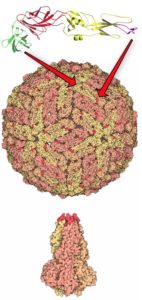

A key step in sexual reproduction is the fusion of haploid cells to form a diploid zygote, yet the molecular mechanism underlying this joining of cells is poorly understood. Two studies reveal amazing similarities between proteins required for fusion of sperm and egg, and virus with host cells.
A screen for genes that cause male sterility in the flowering plant Arabidopsis led to the identification of the HAP2 protein. This protein was later found to be important for sperm-egg fusion in Arabidopsis and in the unicellular algae Chlamyodomonas.
Homology modeling shows that the HAP2 protein looks very much like a class II viral fusion protein (illustrated). Found in dengue virus and many related viruses, dimers of these viral glycoproteins lie flat on the viral membrane, and are comprised largely of beta-strands. At one end of the protein is a fusion loop which allows the virus and cell membranes to join at the start of infection.
The HAP2 protein also has what looks to be a viral fusion loop. Removal or alteration of this sequence in Tetrahymena prevents fusion of mating cells. The fusion loop of the dengue virus E glycoprotein cannot substitute for the HAP2 sequence. Furthermore, vesicular stomatitis viruses with HAP2 in place of the viral glycoprotein cannot enter cells. However the results of biophysical experiments indicate that the HAP2 fusion loop can interact with membrane lipids in ways reminiscent of viral fusion peptides.
Solution of the atomic structure of HAP2 reveals a trimer with protein folds and an upright ‘hairpin’ configuration (illustrated for dengue virus) typical of class II fusion proteins. While acidification of viral type II fusion proteins is required for rearrangement to the post-fusion form, the trigger for HAP2 is not known.
These results clearly show that HAP2 is a type II fusion protein that mediates the joining of haploid gametes in the first step of sexual reproduction. These viral and cell proteins are so similar that it is highly improbable that they arose by convergent evolution. HAP2 is ancient: besides green algae and plants, it is also found in unicellular protozoa, cnidarians, hemichordates, and arthropods, indicating that it was likely present in the last common ancestor of eukaryotes. But viruses existed before the evolution of eukaryotic sex, raising the scenario that type II fusion proteins first arose in viruses, which provided them to eukaryotic cells for use in gamete cell fusion.
Without viruses, there would be no sex, and therefore no humans, or many other animals on Earth.
We continue to recognize new ways that the evolution of eukaryotic life has depended on viruses. These include a viral gene used to produce the placenta; enhancer elements for innate immunity; prions; and the nucleus. What exactly did eukaryotes invent?

OK: So how did eukaryotes ‘know’ that, once they had undergone meiosis to make haploid gametes, the gametes would be able to get back together again? Are we assuming that cells were all haploid to start with, and then they acquired fusion protein DNA from viruses, and were able to double up…
Interesting! (y)